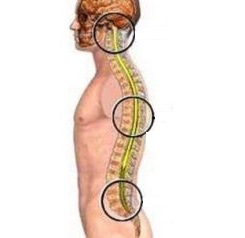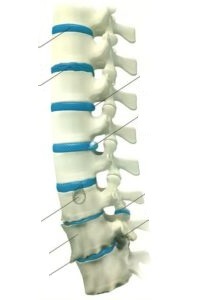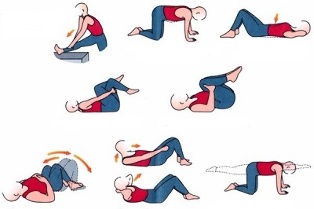Osteochondrosis of the lumbar spine is noted among the pathological processes in the tissues of the axial skeleton, the symptoms and treatment of which have their own characteristics. The frequency of diagnosing the disease does not decrease over time. What is Lumbar Spine Osteochondrosis? This is a special type of degenerative-dystrophic changes in the tissues of the intervertebral discs of the axial skeleton, with subsequent damage to the joints and ligaments. The photo shows the appearance of the affected vertebrae.
Osteochondrosis of the lumbar spine, what is it?

The lumbar spine of the axial skeleton is exposed to maximum stress. As a result, the high frequency of diagnosis of osteochondrosis in this area of the spine is not accidental.
The causes of lumbar osteochondrosis have long been identified and well studied. The disease can manifest itself in patients over 30 years of age. But the older generation and representatives of the strong half of the world community are much more likely to encounter pathology.
Timely treatment of osteochondrosis of the lumbar spine offers the possibility of avoiding a decline in work ability, quality of life and disability.
Sick patients are strictly excluded from hypothermia and vigorous physical activity. Weight lifting, speed skating, jogging, jumping, horseback riding, aerobics, and motor sports are contraindications for osteochondrosis.
Causes of the disease
A number of external and internal factors cause the manifestation of symptoms of degenerative-dystrophic changes in the tissues of the intervertebral discs of the axial skeleton. Symptoms of lumbar spine osteochondrosis, including the back of the back, cause discomfort, discomfort, and stiffness in movements.
Among the reasons for the development of pathology, it should be noted:
- increased loads on the spine in the lumbar region due to certain conditions for performing work tasks, repair work and lifting weights during training by professional athletes and amateurs;
- Execution of sharp, complex movements;
- excess weight, which predetermines the symptoms of lumbar pathology in women and men;
- hypothermia;
- incorrect posture, which leads to an uneven distribution of the load on the axial skeleton;
- sedentary lifestyle, which has a negative effect on elasticity, blood supply to each vertebra;
- inability to sit properly and move about;
- congenital back diseases or back injuries as a result of sport, falls from a height, transport accidents;
- Lack of a balanced diet, enriched with vitamins, minerals, trace elements, as well as the organization of the right regime for food intake, work, rest;
- regular stressful situations;
- hormonal disruption in the female body during pregnancy and menopause;
- violation of metabolic processes in the patient's body;
- genetic predisposition that determines the porous-loose structure of the tissues of the spine and accelerates their degenerative-dystrophic changes;
- Addiction to alcoholic beverages, smoking tobacco products that accelerate the aging process in the human body.
Flat feet, constant wearing of uncomfortable shoes, lack of vitamins, poor environmental conditions of the surrounding area are also the causes of osteochondrosis of the lumbar spine. The exclusion of a number of factors will help avoid the development of pathology. When confirming the diagnosis of lumbar osteochondrosis, it is recommended that it be treated immediately without waiting for complications. Ignoring the advice of qualified specialists leads to the manifestation of dorsalgia and other complications. Vertebrates know how to cure osteochondrosis of the lumbar axial skeleton and provide quick relief for severe pain.
Disease symptoms

The lower spine is an important part of the spine. Timely diagnosis of lumbar osteochondrosis, the treatment of which should begin as early as possible, eliminates the risk of unpleasant consequences. A degenerative-dystrophic disease of the axial skeleton has certain symptoms.
Signs of osteochondrosis of the lumbar spine are included in a special list. The most common are:
- Inability to perform back bends, torso rotations;
- decrease in flexibility, mobility of the lumbar spine, which can be treated at home, according to the recommendations of the doctor;
- depression;
- increased fatigue, irritability, nervousness, which is manifested in osteochondrosis of the lumbar spine, the symptoms and treatment of which have their own characteristics;
- dorsalgia in the lumbar region, causing problems urinating, defecating, and performing daily hygiene measures;
- the occurrence of problems during the night's rest;
- increased sweating;
- the appearance of a tingling sensation and cold in the lower extremities.
Such signs of lumbar osteochondrosis indicate that a qualified specialist must be consulted. Vertebrates will always help cure this disease, improve patients' lives, and rid them of dorsalgia, discomfort, stiffness and discomfort.
Complications of the disease
A long period of degenerative-dystrophic changes in the tissues of the intervertebral discs of the axial skeleton without appropriate treatment leads to the development of complications and associated pathologies of the internal organs of patients. Timely diagnosis of osteochondrosis of the lumbar spine, the symptoms of which indicate the need to seek the help of a vertebrate, eliminates the risk of its occurrence. Ignoring the advice of the attending physician leads to new problems in terms of health, well-being and quality of life.
Complications of lumbar spine osteochondrosis that should be treated without waiting for dorsalgia after the diagnosis has been confirmed include:
- violation of the menstrual cycle in women and sexual activity in men;
- varicose veins and cramps of the foot arteries;
- Dysfunction of the genitourinary system;
- Sciatic nerve irritation and neuralgia;
- Pain that manifests itself in the kidney area and resembles dorsalgia in the lumbar spine;
- protrusions and hernial protrusions of the intervertebral discs and the spine itself;
- Radiculitis, acute and chronic lumbodynia, disability.
The unpleasant consequences of osteochondrosis of the lower back without proper treatment lead to mental disorders, depressive states and a deterioration in the quality of life not only of the patient himself, but also of those around him, his relatives and friends. It is also desirable that they have information about how to diagnose osteochondrosis.
Disease stages
When asked whether it is possible to cure osteochondrosis of the lumbar spine, vertebrologists give a positive answer, provided they seek medical help in good time. They distinguish four stages of the development of the disease, each of which manifests itself at a certain point in time and has its own characteristic features. These include:
- 1st levelpathology, which is characterized by slight sensations of pain, aggravated by physical exertion, discomfort in the lumbar region, the onset of destruction of the intervertebral discs;
- 2nd stageof the disease, characterized by a decrease in the distance between the vertebrae due to pathological changes in the fibrous rings, pinched nerve processes and the appearance of severe pain in lumbar osteochondrosis;
- 3rd stageof the disease, which is characterized by severe destruction of the fibrous rings, the formation of hernial protrusions and a noticeable deformation of the axial skeleton;
- 4th stageof the disease, characterized by severe motor problems in a patient who is forced to treat lower back osteochondrosis at home or in hospital and is at risk of disability.
Pathology diagnostics
Patients are advised to know which doctor treats osteochondrosis of the spine and how osteochondrosis of the lumbar spine is treated at home. The vertebrate, after collecting the anamnesis and external examination of the sick, prescribes the passage of diagnostic measures. Your list contains:
- clinical, biochemical blood test;
- X-ray, which provides the opportunity to obtain information about the condition of the axial skeleton and to prescribe the correct treatment for lumbar osteochondrosis at home or in the hospital; The
- computed tomography, which is characterized by lower radiation exposure of the body, allows a more thorough examination of the pathological zone of the axial skeleton and the answer to the question of whether osteochondrosis can be treated at this stage of development.
- Magnetic resonance imaging, based on the use of electromagnetic radiation, as well as providing an absolutely painless, harmless examination of the back in the case of osteochondrosis of the lumbar spine.
Modern diagnostic methods are among the most informative research methods. Their results form the basis for confirming the diagnosis of osteochondrosis of the lumbar spine, the symptoms of which indicate the presence of a back problem, and also provide an opportunity to prescribe the correct treatment for the pathology of the axial skeleton.
How to deal with osteochondrosis and how to get rid of its symptoms
Vertebrates who can treat osteochondrosis of the axial skeleton of the lumbar spine at home will always come to the aid of sick patients. After receiving the results of the examination of the pathological zone of the spine, a number of measures are prescribed to relieve the symptoms of the disease and prevent the development of complications. Treatment schemes for osteochondrosis of the lumbar spine are developed taking into account the age category of the patient and the structural features of the axial skeleton. Allergies are also noted, which can manifest themselves against the background of taking drugs.
The most important measures for the effective treatment of osteochondrosis are:

- drug therapy based on the intake of non-steroidal anti-inflammatory drugs, Hodroprotectors, muscle relaxants, vitamin complexes, phytopreparations;
- perform blockades that eliminate severe pain in lumbar osteochondrosis, the symptoms of which have their own characteristics;
- water treatments and stretching the axial skeleton, which should be done regularly;
- medical massage;
- Exercise therapy, which is prescribed to strengthen the muscle frame, make the vertebrae more flexible, and not ask how to cure lumbar osteochondrosis;
- according to traditional medicine recipes.
Treatment of osteochondrosis of the lower back takes place against the background of a balanced diet. Rejection of bad habits is also a necessary measure to prevent the disease from progressing. Orthopedic prevention of osteochondrosis of the lumbar spine provides the opportunity to avoid surgery.







































